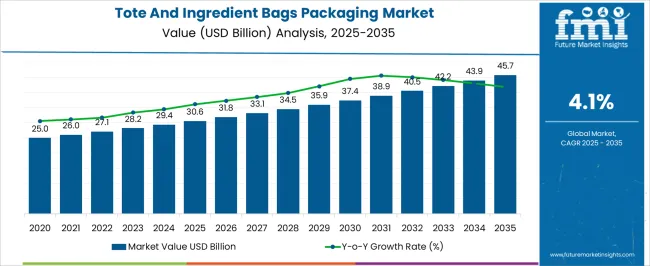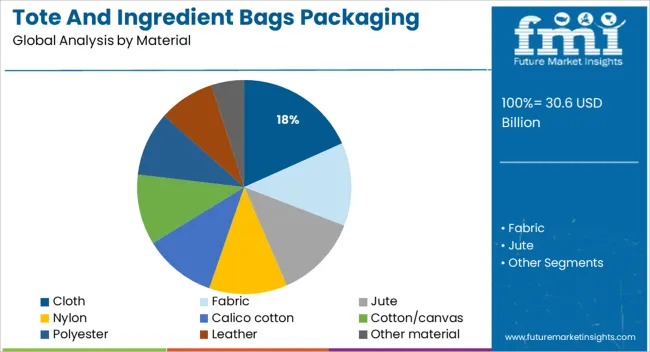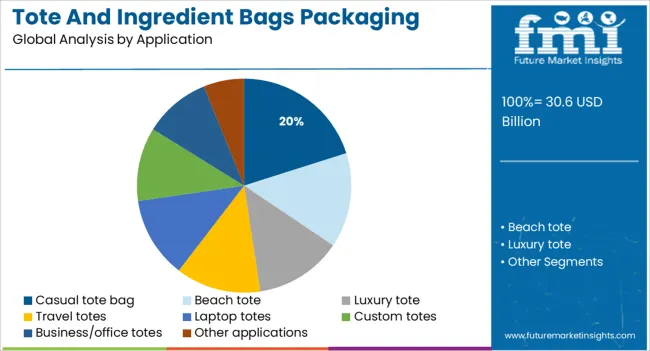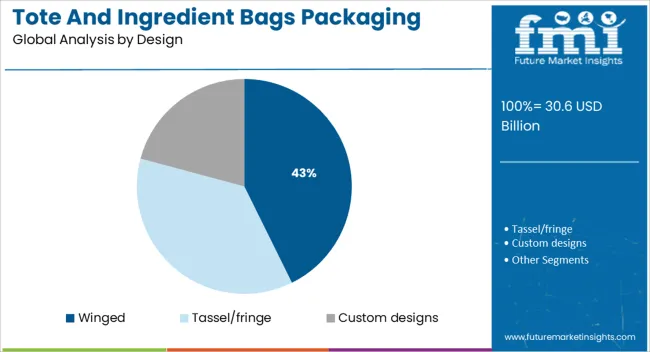The Tote And Ingredient Bags Packaging Market is estimated to be valued at USD 30.6 billion in 2025 and is projected to reach USD 45.7 billion by 2035, registering a compound annual growth rate (CAGR) of 4.1% over the forecast period.

| Metric | Value |
|---|---|
| Tote And Ingredient Bags Packaging Market Estimated Value in (2025 E) | USD 30.6 billion |
| Tote And Ingredient Bags Packaging Market Forecast Value in (2035 F) | USD 45.7 billion |
| Forecast CAGR (2025 to 2035) | 4.1% |
The tote and ingredient bags packaging market is experiencing notable expansion, supported by increasing adoption of reusable alternatives across both lifestyle and functional categories. With environmental regulations tightening and consumer preferences shifting toward eco-conscious products, brands are focusing on sustainable materials and versatile formats. Cloth-based and biodegradable textiles are being prioritized to reduce plastic usage and improve brand image in retail and packaging sectors.
Ingredient bags are seeing rising application in bulk food, grains, and agricultural produce, while tote bags are gaining popularity in both urban retail and promotional merchandise. As personalization and lifestyle integration gain momentum, bag manufacturers are innovating in design, print customization, and ergonomic form factors to meet diverse user needs.
The market outlook remains positive as retail, grocery, and wellness industries integrate branded, reusable tote and ingredient bags into their supply chain and customer engagement strategies. Continued innovation in material sourcing, along with scalability in production and design flexibility, is expected to support long-term market penetration.
The market is segmented by Material, Application, Design, Ingredient Type, and Size and region. By Material, the market is divided into Cloth, Fabric, Jute, Nylon, Calico cotton, Cotton/canvas, Polyester, Leather, and Other material. In terms of Application, the market is classified into Casual tote bag, Beach tote, Luxury tote, Travel totes, Laptop totes, Custom totes, Business/office totes, and Other applications. Based on Design, the market is segmented into Winged, Tassel/fringe, and Custom designs. By Ingredient Type, the market is divided into Flour, Sugar, Various chemicals, and Other ingredients. By Size, the market is segmented into Small ingredient bags (<30 ingredients, 1000 stacks), Medium ingredient bags (31–45 ingredients, 1001–2500 stacks), Large ingredient bags (46–80 ingredients, <2500 stacks), Extra-large ingredient bags (81–150 ingredients, 2501–5000 stacks), Huge ingredient bags (151–250 ingredients, <5000 stacks), Gargantuan ingredient bags (251–500 ingredients, 5001–10,000 stacks), and Colossal ingredient bags (<1000 ingredients, <2500 stacks). Regionally, the market is classified into North America, Latin America, Western Europe, Eastern Europe, Balkan & Baltic Countries, Russia & Belarus, Central Asia, East Asia, South Asia & Pacific, and the Middle East & Africa.

The cloth subsegment is projected to hold 18.3% of the overall material category revenue in 2025, reflecting its growing preference among manufacturers and consumers. This share is being supported by cloth’s perceived sustainability, durability, and compatibility with a wide range of printing and branding techniques.
Retailers and brands have increasingly adopted cloth-based tote and ingredient bags as part of their eco-marketing efforts, especially in regions with rising restrictions on single-use plastic. The tactile appeal and ease of cleaning have further driven its selection among value-conscious and environmentally aware consumers.
Additionally, cloth materials offer versatility in structural reinforcement and styling, enabling manufacturers to serve both utility and fashion markets. With the growth in reusable packaging mandates and lifestyle-oriented retail, cloth continues to gain traction as a premium yet accessible material in this segment.

The casual tote bag application is anticipated to contribute 20.1% of the market’s application revenue in 2025, making it a key segment in this category. This is being influenced by shifting fashion trends and a growing preference for multipurpose everyday carry solutions. Casual totes have become prominent as brands invest in reusable promotional bags, workplace utility bags, and grocery-friendly styles that combine functionality with modern aesthetics.
Demand has also increased due to the bag’s versatility, lightweight construction, and customizability. Retailers have embraced casual totes for their marketing potential, offering branded options as part of loyalty programs and in-store promotions.
Furthermore, consumers are favoring casual tote bags for their portability and extended usability across personal, professional, and shopping contexts. The convergence of affordability and lifestyle compatibility has reinforced its strong share in the application segment.

The winged design segment is forecast to account for 42.7% of total revenue in the design category in 2025, leading the segment due to its functional and stylistic advantages. The winged structure enhances storage capacity while maintaining a compact base, making it ideal for both retail and ingredient bag applications. Consumers are increasingly attracted to winged designs for their expanded utility and modern appearance.
Manufacturers have adopted this format for its structural integrity and ease of handling, especially in the food, agricultural, and apparel sectors. The winged layout also allows better weight distribution and facilitates stackability, which appeals to both logistics providers and end users.
As brand aesthetics and practicality intersect in packaging, the winged design is being integrated into a growing range of reusable and specialty bags. Its ability to bridge premium presentation with operational ease has solidified its dominance within the design segment.
The importance of packaging of products lies in the protection of the products from UV rays, dirt and other contaminants during transportation. Packaging is of two types primary and secondary. Primary packaging comprises of the layer of packaging immediately in contact with the product. Secondary packaging is a second layer of packaging that is used during transportation over short distances. Secondary package may also contain a set of primary packaged products.
Tertiary packaging is used for transport over long distances or storage of bulk. Tote bags represent secondary packaging. Tote bags are unfastened bags with parallel handles protruding from both sides to provide convenience in carrying. They may be made of jute, fabric and leather. Ingredient bags serve as primary packaging for the transport of raw ingredients. The preference for Tote bags in the market is high due to their cost effectiveness and reusability.
The global packaging market has increased in the past couple of decades resulting in an increased demand for custom products and ease of transport. The retail sector growth in the developed market has been moderate, around 5%, and is higher than 8% in the developing market, therefore, it is anticipated that this will allow the Tote bag packaging market to grow substantially.
The food industry is also anticipated to experience a steady growth in emerging markets like Argentina, Brazil, China and India. These conditions are anticipated to fuel the growth of the ingredient bag market. Additionally, properties like foldability, customizability and recyclability of Tote bags increase their preference backed up by an improvement in the standard of living. All these conditions catalyze the growth of the Tote bag packaging market.
Despite the favorable conditions for the growth of the Tote bag packaging market, there are certain factors that hinder the growth like the environmental concerns. Toxic waste is generated from the plants and affect the nearby areas raising concerns among local residents. Stringent environmental policies are likely to impede the growth of the otherwise robust market.
Geographically, the Global tote bag packaging market is segmented into North America, Latin America, Europe, Middle East and Africa (MEA) and Asia Pacific. The tote bag packaging market is anticipated to witness an impressive CAGR in the 2020-2025 timeframe. Being a mature market, North America leads the tote bag packaging market share in the global tote bags packaging market, however, Europe and North America will experience moderate growth owing to their mature markets.
The retail sector in China and India has shown a steady growth, owing to the increase in the number of retail outlets and malls, and is set to fuel the growth of the tote bag packaging market in the Asia-Pacific region. Emerging economies such as Argentina, Brazil, China and India will drive the growth of tote bag packaging market in Latin America and Asia Pacific respectively, and are anticipated to emerge as lucrative markets by the end of the 2020-2025 timeframe.
Some of the key players in the tote bag packaging market are Bustificio Enneci, Xiamen Novelbag Co. ltd., Nanchang cloud power E-commerce co., Flymax Exim, Pico Bags, Xiamen Daike bags co. ltd. and MCM-group.
The research report presents a comprehensive assessment of the market and contains thoughtful insights, facts, historical data, and statistically supported and industry-validated market data. It also contains projections using a suitable set of assumptions and methodologies. The research report provides analysis and information according to market segments such as geography, technology, and applications.
The report is a compilation of first-hand information, qualitative and quantitative assessment by industry analysts, inputs from industry experts and industry participants across the value chain. The report provides in-depth analysis of parent market trends, macro-economic indicators and governing factors along with market attractiveness as per segments. The report also maps the qualitative impact of various market factors on market segments and geographies.
The global tote bag packaging market can be segmented as follows:-
The ingredient bag packaging market can be segmented as follows:
The global tote and ingredient bags packaging market is estimated to be valued at USD 30.6 billion in 2025.
The market size for the tote and ingredient bags packaging market is projected to reach USD 45.7 billion by 2035.
The tote and ingredient bags packaging market is expected to grow at a 4.1% CAGR between 2025 and 2035.
The key product types in tote and ingredient bags packaging market are cloth, fabric, jute, nylon, calico cotton, cotton/canvas, polyester, leather and other material.
In terms of application, casual tote bag segment to command 20.1% share in the tote and ingredient bags packaging market in 2025.






Full Research Suite comprises of:
Market outlook & trends analysis
Interviews & case studies
Strategic recommendations
Vendor profiles & capabilities analysis
5-year forecasts
8 regions and 60+ country-level data splits
Market segment data splits
12 months of continuous data updates
DELIVERED AS:
PDF EXCEL ONLINE
Assessing Tote Bag Market Share & Industry Trends
Tote Bag Market Growth, Trends, Forecast 2024-2034
Tote Bin Market Trends – Growth & Forecast 2024-2034
ESD Totes Market Size and Share Forecast Outlook 2025 to 2035
Frontotemporal Disorders Treatment Market Size and Share Forecast Outlook 2025 to 2035
Frontotemporal Dementia (FTD) Management Market – Trends & Future Outlook 2025 to 2035
Bulk Tote Dumpers Market
Wine Totes Packaging Market Size and Share Forecast Outlook 2025 to 2035
Plastic Lab Totes Market
Safety Bottle Tote Carriers Packaging Market Size and Share Forecast Outlook 2025 to 2035
Reusable Grocery Tote Market Analysis - Size and Share Forecast Outlook 2025 to 2035
Farming Sack and Tote Market Size and Share Forecast Outlook 2025 to 2035
Android Automotive OS (AAOS) Market Size and Share Forecast Outlook 2025 to 2035
Anderson Cascade Impactor Market Size and Share Forecast Outlook 2025 to 2035
Andersen-Tawil Syndrome Treatment Market Trends - Growth & Future Prospects 2025 to 2035
Andro Supplements Market
Handheld Electrostatic Meter Market Size and Share Forecast Outlook 2025 to 2035
Hand Towel Automatic Folding Machine Market Size and Share Forecast Outlook 2025 to 2035
Handheld Ultrasound Scanner Market Size and Share Forecast Outlook 2025 to 2035
Handheld Tagging Gun Market Forecast and Outlook 2025 to 2035

Thank you!
You will receive an email from our Business Development Manager. Please be sure to check your SPAM/JUNK folder too.
Chat With
MaRIA